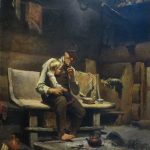
The facade is bordered on the north and south by two towers and includes three main door
ways, each of which

Above the central doorway, facing the

The central door leads to the main patio which is surrounded by Baroque arches. Only the balustrade of this area has been remodeled, conserving the murals by Diego Rivera that adorn the main stairwell and the walls of the second floor. In the stairwell is a mural depicting the history of Mexico from 1521 to 1930, and covers an area of 450 m2 (4800 ft2). These murals were painted between 1929 and 1935, jointly titled “The Epic of the Mexican People”. The work is divided like a triptych with each being somewhat autonomous. The right-hand wall contains murals depicting pre-Hispanic Mexico and centers around the life of the Aztec god Quetzalcóatl.
Introducing Quetzalcóatl
Quetzalcóatl appears in the mural as a star, a god, and a human being. Created by serpents, he sails through space as a star that accompanies the sun at night. Quetzalcóatl then assumes a human body to teach the Aztec people as their king and patriarch. Last, when he sacrifices his blood to give life to men, he returns to the sky having completed his earthly cycle. Once he leaves the earth, Quetzalcóatl assumes the shape the morning star, called Tlahuizcalpantecuhtli. The cycle that he undergoes signifies the continuous cycle of life. Rivera’s creation of a Mexican identity helps to continue the reform that began with the Mexican Revolution of 1910. Before this time, any individualism from the Indians was discouraged as well as

In the middle and largest panel, the Conquest is depicted with its ugliness, such as rape and torture, as well as priests defending the rights of the indigenous people. The battle for independence occupies the uppermost part of this panel in the arch. The American and French invasions are represented below this, as well as the Reform period and the Revolution. The left-hand panel is dedicated to early and mid-20th century, criticizing the status quo and depicting a Marxist kind of utopia, featuring the persons of Plutarco Elías Calles, John D. Rockefeller, Harry Sinclair, William Durant, J.P. Morgan, Cornelius Vanderbilt

On north annex of the building is the Treasury Room and the Benito Juárez Museum. Between the two is the Empress Stairway, built by brothers Juan and Ramón




